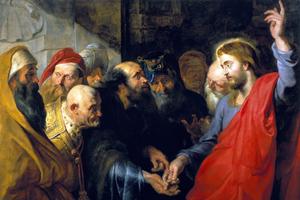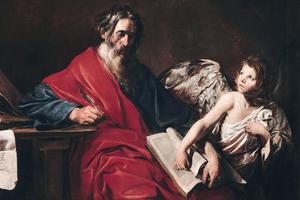Satisfying and Unsatisfying Labor — 18th Sunday in Ordinary Time
SCRIPTURES & ART: “I am the bread of life; whoever comes to me will never hunger, and whoever believes in me will never thirst.” (John 6:35)

Today’s First Reading, from Exodus, tells how God sent bread from heaven to feed the Israelites during their sojourn in Sinai.
Freedom is not free: it entails sacrifice. The Israelites, who had already seen God’s mighty and in the plagues upon Egypt (particularly the death of the firstborn) and their deliverance from them as well as their miraculous rescue at the Red Sea, still vacillate. The Bible explains their 40-year journey as punishment for their lack of faith, particularly their return to idol worship after all God had done for them. But I also value the insight of one commentator who stressed that those 40 years were needed for the original generation to die out.
Why? In today’s reading, the Israelites are again doing what they seem to excel at: complaining against God. “Would we have died at the Lord’s hand in the land of Egypt,” where we were full, rather than out here in nowhere, hungry! (Exodus 16:3). Only a generation that is “tested” would be capable of building a new nation. For that generation to succeed, the generation that constantly hankered after Egypt (something on the lines of “better the devil you know”) had to be gone.
God “tests” (Exodus 16:4b) them by giving them bread from heaven. The word “manna” is rooted in the Hebrew pronoun for “what?” indicative of its miraculous and unknown origin. Manna appeared in the morning, something like frost. God instructs the Israelites to gather only their daily bread, a day’s portion, except on Fridays when they would gather a two-day portion to avoid Sabbath work. Excess manna rotted, except for the portion miraculously preserved on the Sabbath Eve (pointing to God’s miraculous work in the Eucharist, too).
Various natural causes have been attributed for manna, ranging from secretions of tamarisk or oak trees to lichens to honeydew from insects. I prescind from this speculation: like the account of creation, the Bible seeks to stress that God fed his people and created a universe, not how he did it. The point is that, thanks to divine intervention in the form of manna and quail, the Israelites did not starve.
The Church uses this First Reading today to connect last Sunday’s Gospel about Jesus’ multiplication of the loaves and fishes with today’s Gospel where he explains the meaning of his sign. “It was not Moses who gave you bread from heaven; my Father gives you the true bread from heaven; for the bread of God is that which comes down from heaven and gives life to the world” (John 6:32-33).
Jesus’ multiplication of the loaves, recounted in last Sunday’s Gospel, caused the crowd to want to make Jesus a king and for him to evade them. Once again, they catch up to him and he tells them bluntly they are seeking him “not because you saw signs but because you ate the loaves and were filled” (verse 26), challenging them to seek instead the spiritual food “which the Son of Man will give you” (verse 27) in whom they should believe (verse 29).
Like the Israelites in the desert, who beheld repeated signs of God’s solicitude for them yet still griped, the crowd around Jesus, who have just seen the sign of his multiplication of loaves, challenge him: “What sign can you do, that we may see and believe in you?” (verse 30).
Uh, didn’t you just have one?
Jesus then speaks of the bread from heaven. “Sir, give us this bread always,” the crowd asks.
The echoes of an earlier dialogue with the Samaritan woman can be heard here. When Jesus promises to give her “living water” that springs up to everlasting life, she also asks for it “so that I won’t get thirsty and have to keep coming here to draw water” (John 4:13-15).
Both the just-fed crowd and the Samaritan woman think of Jesus as some kind of “Handy Housewife Helper” salesman, offering bread that doesn’t run out and eternally thirst-slaking water. And if it could only “core a apple…”
Before Jesus can talk to them about spiritual things, he has to move their horizons beyond the sensual, the temporal and the utilitarian. (He has the same challenge with the Samaritan woman moving beyond her sinful lifestyle, which is why Jesus first tells her to go and get her “husband” to accompany her.) Whether he succeeds future Gospels will tell us.
Jesus is clear: “I am the Bread of Life; whoever comes to me will never hunger, and whoever believes in me will never thirst” (verse 35). “I am,” a term Jesus repeatedly invokes in John’s Gospel, clearly alludes to God’s sacred name revealed to Moses (Exodus 3:14) with which Jesus identifies himself in John’s Gospel (John 18: 5, 8).
John 6, in which Jesus expounds his Eucharistic teaching, is a paradoxical text because, while many Protestants are otherwise inclined to a literal reading of Sacred Scripture, they usually turn this passage into a purely allegorical or spiritual meaning in order to ground their devaluation of the Eucharist. We should not be surprised; it is precisely what the crowd surrounding Jesus does when they hear him out and, presumably with bellies still full from their free lunch, turn away from him.
Bernadino Luini portrays the gift of the manna in his work painted around the year 1520. Luini, a High Renaissance artist from what is today northern Italy, was a contemporary of Raphael and Leonardo da Vinci. His active artistic life occurred in the first third of the 16th century.
The work depicts the labor of gathering manna. Ten people are actively engaged in that task. The right side of the painting draws us into it starting with the woman in the foreground, her head tilted towards us, and the woman directly behind her looking towards us. So does the angelic little child who is snacking on manna: kids have an attraction, even if they are not focusing right on us. The man, seemingly also at work, has his face at least partially towards us. The others are turned away, at their task. Last week’s Gospel featured Jesus telling his Apostles to gather the excess bread into baskets; five baskets are evident in today’s picture, even if the rules for manna prohibited collecting more than one’s quotidian quota.
The wintry season is a clear allusion to manna being like hoarfrost, and Sinai had mountains. Luini, on the other hand, is also prone to Renaissance anachronism, i.e., inserting the models of his day into Biblical scenes. The people gathering manna are clearly dressed as they would be in the 16th century A.D., rather than 2,600 or so years earlier. The town and townspeople in the upper right might have existed around Buini’s native Lake Maggiore, but certainly did not in the Sinai Peninsula.
I chose this simple work because it focuses on the work of gathering manna — the Old Testament’s “bread from heaven” involves human labor. (If you want a theologically richer presentation of the Manna in the Desert, try Poussin’s work — While Jesus’ “Bread from Heaven” also entails “the work of human hands,” it is above all a gratuitous gift and initiative of God’s, a Bread that is forever filling, in contrast to the labor intensive effort required to gather “food that perishes.”)
What Jesus will tell that crowd will be another sign of contradiction, another dividing line that causes many of them to abandon him. While God offers food “without money and without cost,” asking why we should spend “money on what is not bread and your labor on what does not satisfy” (Isaiah 55:1-2), history clearly reveals the human preference to do just that in pursuit of the perishable.
- Keywords:
- sunday readings
- gospel
















